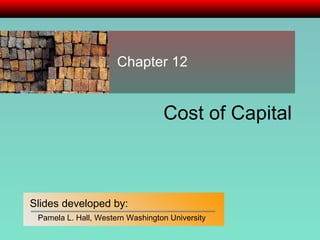
Chapter 12 Cost Of Capital
- 1. Cost of Capital Chapter 12
- 9. The Weighted Average Calculation—Example Q: Calculate the WACC for the Zodiac Company given the following information about its capital structure. A: First we need to calculate the capital structure weights based on the value given. For debt this weight is $60,000 $200,000 = 30%. Next, each component’s cost is multiplied by its weight and the results are summed as shown below: Example $200,000 14 90,000 Common stock 11 50,000 Preferred Stock 9% $60,000 Debt Cost Value Capital Component WACC = 14 11 9% Cost 100% 45% 25% 30% Weight 11.75% $200,000 6.30% 90,000 Common stock 2.75% 50,000 Preferred Stock 2.70% $60,000 Debt Value Capital Component
- 12. Developing Market-Value-Based Capital Structure—Example Q: The Wachusett Corporation has the following capital situation. Debt: Two thousand bonds were issued five years ago at a coupon rate of 12%. They had 30-year terms and $1,000 face values. They are now selling to yield 10%. Preferred stock: Four thousand shares of preferred are outstanding, each of which pays an annual dividend of $7.50. They originally sold to yield 15% of their $50 face value. They're now selling to yield 13%. Equity: Wachusett has 200,000 shares of common stock outstanding, currently selling at $15 per share. Develop Wachusett's market-value-based capital structure. Example
- 13. Developing Market-Value-Based Capital Structure—Example A: To determine the market value of each source of capital, the market value (total) of each source must be calculated and then its percentage determined. The price of Wachusett's bonds in the market must be determined. We know the bonds have 25 years remaining until maturity, pay interest of $120 annually ($60 semi-annually) and are yielding 10% annually (5% semi-annually). Thus, each bond is selling for $1,182.55 in the market, calculated as shown below. Because there are 2,000 bonds outstanding, the market value of the firm's debt is $2,365,100, or $1,182.55 x 2,000. Example P b = PMT[PVFA k,n ] + FV[PVF k,n ] = $60[PVFA 5,50 ] + $1,000[PVF 5,50 ] = $60(18.2559) + $1,000(0.0872) = $1,182.55
- 14. Developing Market-Value-Based Capital Structure—Example The firm's preferred stock represents a perpetuity that pays $7.50 annually and is yielding 13%. Thus, the value of each share of preferred stock is $57.69, or $7.50 .13. Because there are 4,000 shares outstanding, the total market value of Wachusett's preferred stock is $230,760, or $57.69 x 4,000. Each share of Wachusett's common stock is trading for $15, thus the total market value of the firm's equity is $3,000,000, or $15 x 200,000 shares. Next, we calculate the portion of the the firm's total capital that each source represents: Example 100.0% $5,595,860 53.6 3,000,000 Equity 4.1 230,760 Preferred 42.3% $2,365,100 Debt
- 19. The Cost of Preferred Stock—Example Q: The preferred stock of the Francis Corporation was issued several years ago with each share paying 6% of a $100 par value. Flotation costs on new preferred are expected to average 11% of the funds raised. (a) What is Francis's cost of preferred capital if the interest rate on similar preferred stock is 9% today? (b) Calculate Francis's cost of preferred stock if the stock is selling at $75 per share today. A: Questions (a) and (b) are both asking the same question; however with (a) we have the market return provided and with (b) we are given the information needed to calculate the market return. (a) Using the formula k p (1 - f) we simply adjust the market return by flotation costs: 9% (1 - .11) = 10.1%. (b) Using the formula D p (1 - f) P p we calculate the cost using the dividend and current price of preferred stock: (6% × $100) (1-.11)$75 = 9%. Example
- 29. Figure 12.2: MCC Schedule and IOS Projects A, B and C should be undertaken because their expected returns exceed the expected costs.
